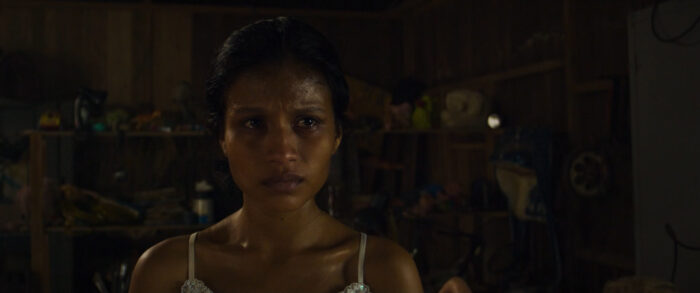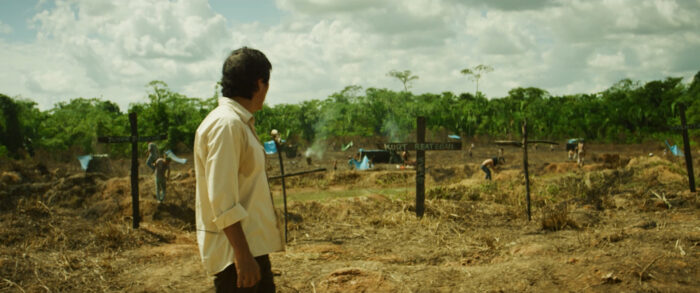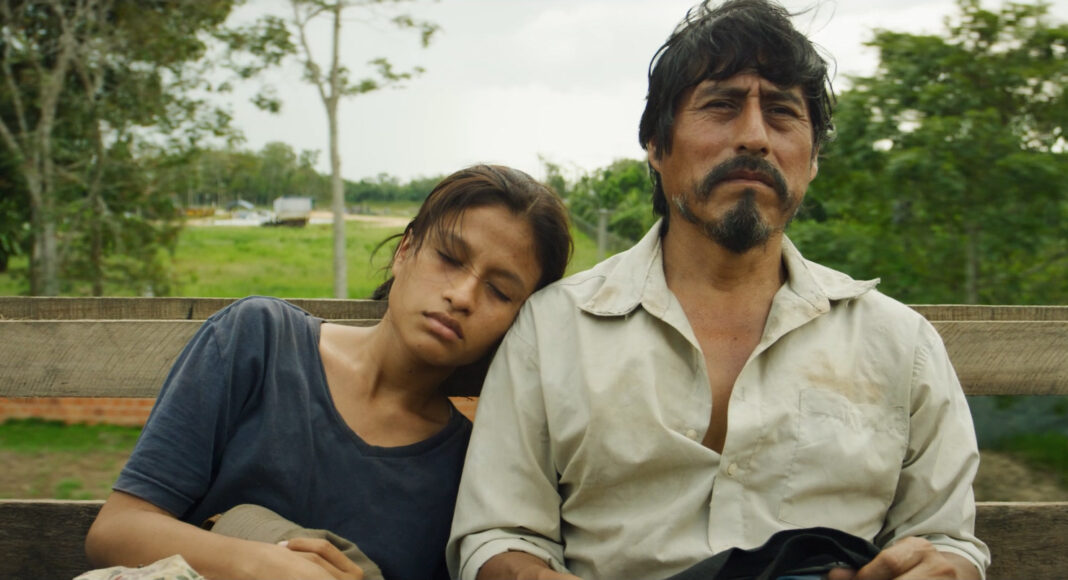It is impossible not to be impacted by Peruvian director Dorian Fernández-Moris’s compelling drama, The Invisible Girl (La Pampa in Spanish), in which we are transported to the town of La Pampa, an illegal gold mining site in the Peruvian Amazon. There we follow the saga of Reina, a 15-year-old girl who escapes La Pampa where she had been forced into sexual slavery, helped by another women from the brothel who worries about the teenager’s deteriorated health. The two flee during the night and head to Juan’s house begging for help. Juan, a despondent middle-aged man tormented by a tragic loss, ultimately joins the girl in finding her family. But escaping the members of the criminal group that controls the region seems to be an insurmountable task.

Juan and Reina, brilliantly played by Fernando Bacilio and Luz Pinedo, are victims of the same vicious criminality. They both live oppressive lives: she is a victim of human trafficking brought to the improvised La Pampa to serve men flush with cash from gold sales, and he is a fugitive and a former government official haunted by ghosts from his past. By a stroke of fate their stories become intertwined, and he embraces the opportunity to redeem himself by taking her under his protection. Despite all the oppression, they ultimately take back the reigns of their fate, for better or worse.
The captivating dramatic plot written by Fernández-Moris and Rogger Vergara Adrianzén recounts the devastating impact of barefaced exploitation of land and people in La Pampa, a small Amazonian town 60 miles from the nearest city, in the period following the gold rush in Peru. The socio-environmental conflict and the burden faced by Peru’s poorest populations is vividly portrayed, giving a shocking sense of the very real dimensions of destruction in this area: illegal miners arrived and cleared trees to mine gold, creating toxic mercury-filled pools in the process. This has transformed vast areas of rainforest into wasteland, threatening the health of the land and its inhabitants, most of whom arrived here as illegal miners, given the price of gold made it the most lucrative illicit business in the country, more so than cocaine production. Nevertheless, according to estimates, four in ten of the near half a million inhabitants there live in poverty.

The storyline is well developed, providing a clear picture of the characters’ past and of the daily lives of the locals in town. In no time viewers are absorbed by the characters’ struggles. Despite being a work of fiction, The Invisible Girl was based on a true story, and it often feels this is a true depiction of the reality of La Pampa. Fernández-Moris attests that everybody knows about stories like that of the woman who Reina was based on, yet they pay no attention. When cases are brought to authorities, they often go unpunished. This overwhelmingly affects the many women and minors who time and time again are forced into sex slavery.
Illegal mining in La Pampa – and in all of Latin America – is linked not only to the exploitation of land for its mineral resources, but also to corruption, money laundering, extreme violence, killings, and to all types of often invisible crimes involving female victims and minors. Violence on the land leads to violence on the female body, through health issues and especially reproductive health issues, as well as sexual violence and trafficking, as horrifically demonstrated in La Pampa. The illicit economy gives rise to settlements around it and in many examples is the sole responsible for making local economies move. That was the case in La Pampa, where at night brothels boomed with music and women (and children) were offered by criminals to paying miners. The Invisible Girl moves you to wonder how women can conform to a life like this, and urges you to understand how poverty, inequality, and less-than-desired living conditions in Peru amount to hundreds of thousands of extremely vulnerable workers falling prey to labour exploitation and human traffic.
Luis Vera, head of Peru’s environmental police force explained to the Guardian that in La Pampa: ‘There was no authority, there was prostitution, hired killings, [forced] disappearances and people trafficking. There was every kind of illicit business and all types of crimes with a lot of female victims, including minors.’
Yet during the course of the production, there have been significant changes in La Pampa. A few years ago, Vera led a successful Peruvian government operation (Operation Mercury) to crack down on illegal activity in La Pampa. According to the Monitoring of the Andean Amazon Project (MAAP), illegal gold mining deforestation decreased by 62 per cent overall across all sites following Operation Mercury, including a remarkable 96 per cent decrease in La Pampa.
However, mining continues in other areas and illegal exploitation remains a serious issue in many parts of Latin America (and the world); Brazilian Indigenous communities have been especially brutally affected by these dynamics. Still today, many people remain vulnerable to child labour, hazardous working conditions, and human trafficking, not to mention the threat posed to their security by the environmental degradation resulting from uncontrolled resource extraction. It takes firm commitment and political resolve, and a good amount of time for healing, but the environment can be restored.

The Invisible Girl leaves you wondering how many women forced into prostitution, just like Reina, were able to go back to their families and start a different life. Were they offered a new chance after the authorities dismantled the mining camps in the region of Madre de Dios, or did they simply move to a different place where illicit economy was still booming?
The film has already been selected for nine international festivals and is being screened in Europe and Latin America. Its success opens doors for shining light onto such atrocities and sparking a public debate about human right abuses linked to illegal mining. If the film ends on a bitter note, it also offers a ray of hope. Its strong characters and deeply emotional and true-to-life narrative command the viewers’ attention, capture their hearts, and serve as a wake-up call to the importance of government response. The Invisible Girl visibilizes women like Reina and endows them with the attention, respect, and care they unquestionably deserve.


